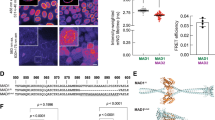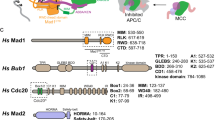Abstract
The multisubunit anaphase promoting complex (APC) is an essential cell-cycle regulator. Although CDC26 is known to have a role in APC assembly, its molecular function has remained unclear. Biophysical, structural and genetic studies presented here reveal that CDC26 stabilizes the structure of APC6, a core TPR protein required for APC integrity. Notably, CDC26–APC6 association involves an intermolecular TPR mimic composed of one helix from each protein.
This is a preview of subscription content, access via your institution
Access options
Subscribe to this journal
Receive 12 print issues and online access
$189.00 per year
only $15.75 per issue
Buy this article
- Purchase on Springer Link
- Instant access to full article PDF
Prices may be subject to local taxes which are calculated during checkout


Similar content being viewed by others
Accession codes
References
Dube, P. et al. Mol. Cell 20, 867–879 (2005).
Gieffers, C., Dube, P., Harris, J.R., Stark, H. & Peters, J.M. Mol. Cell 7, 907–913 (2001).
Han, D., Kim, K., Kim, Y., Kang, Y. & Lee, J.Y. J. Biol. Chem. 284, 15137–15146 (2009).
Ohi, M.D. et al. Mol. Cell 28, 871–885 (2007).
Passmore, L.A. et al. Mol. Cell 20, 855–866 (2005).
Thornton, B.R. et al. Genes Dev. 20, 449–460 (2006).
Das, A.K., Cohen, P.T.W. & Barford, D. EMBO J. 17, 1192–1199 (1998).
Cliff, M.J., Williams, M.A., Brooke-Smith, J., Barford, D. & Ladbury, J.E. J. Mol. Biol. 346, 717–732 (2005).
Yamada, H., Kumada, K. & Yanagida, M. J. Cell Sci. 110, 1793–1804 (1997).
Yoon, H.J. et al. J. Biol. Chem. 281, 32284–32293 (2006).
Wehman, A.M., Staub, W. & Baier, H. Dev. Biol. 303, 144–156 (2007).
Araki, H., Awane, K., Ogawa, N. & Oshima, Y. Mol. Gen. Genet. 231, 329–331 (1992).
Zachariae, W. et al. Science 279, 1216–1219 (1998).
Zachariae, W., Shin, T.H., Galova, M., Obermaier, B. & Nasmyth, K. Science 274, 1201–1204 (1996).
Groves, M.R. & Barford, D. Curr. Opin. Struct. Biol. 9, 383–389 (1999).
Lai, L.A., Morabito, L. & Holloway, S.L. Mol. Genet. Genomics 270, 156–164 (2003).
Samejima, I. & Yanagida, M. J. Cell Biol. 127, 1655–1670 (1994).
Wang, Q. et al. Oncogene 22, 1486–1490 (2003).
Matyskiela, M.E. & Morgan, D.O. Mol. Cell 34, 68–80 (2009).
Vodermaier, H.C., Gieffers, C., Maurer-Stroh, S., Eisenhaber, F. & Peters, J.M. Curr. Biol. 13, 1459–1468 (2003).
Acknowledgements
We are indebted to D. King (Howard Hughes Medical Institute Mass Spectrometry Laboratory), S. Otieno and R. Kriwacki for assistance with CD, C. Ross and D. Miller for computational support and D.W. Miller and S. Bozeman for administration. This work was funded by the American Lebanese Syrian Associated Charities (ALSAC), the US National Institutes of Health (NIH) (P30CA021765 to St. Jude Cancer Center), a Beckman Young Investigator Award to B.A.S. and the Howard Hughes Medical Institute. NECAT beamlines (Advanced Photon Source (APS)) are supported by RR-15301 from the National Center for Research Resources at NIH. APS is supported by the US Department of Energy, Office of Basic Energy Sciences, contract W-31-109-ENG-38. B.A.S. is an Investigator of the Howard Hughes Medical Institute.
Author information
Authors and Affiliations
Contributions
J.W. designed, performed and analyzed biochemical, biophysical and crystallography experiments and wrote the manuscript; B.T.D. designed, performed and analyzed biochemical and yeast genetic experiments and wrote the manuscript; K.R.R. and I.K. performed and analyzed crystallography experiments; B.A.S. advised on all aspects of the project and wrote the manuscript.
Corresponding author
Supplementary information
Supplementary Text and Figures
Supplementary Figures 1–6, Supplementary Table 1 and Supplementary Methods (PDF 4843 kb)
Rights and permissions
About this article
Cite this article
Wang, J., Dye, B., Rajashankar, K. et al. Insights into anaphase promoting complex TPR subdomain assembly from a CDC26–APC6 structure. Nat Struct Mol Biol 16, 987–989 (2009). https://doi.org/10.1038/nsmb.1645
Received:
Accepted:
Published:
Issue Date:
DOI: https://doi.org/10.1038/nsmb.1645
This article is cited by
-
Integrating genetic, transcriptional, and biological information provides insights into obesity
International Journal of Obesity (2019)
-
Paf1 and Ctr9 subcomplex formation is essential for Paf1 complex assembly and functional regulation
Nature Communications (2018)
-
Array-CGH diagnosis in ovarian failure: identification of new molecular actors for ovarian physiology
Journal of Ovarian Research (2016)
-
Spatiotemporal regulation of the anaphase-promoting complex in mitosis
Nature Reviews Molecular Cell Biology (2015)
-
Architecture of the Saccharomyces cerevisiae RNA polymerase I Core Factor complex
Nature Structural & Molecular Biology (2014)



